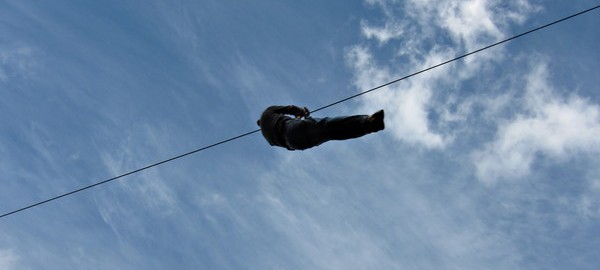(Many thanks to Ann Marie for suggesting an activity I would never have thought of for myself)
I am afraid of heights, and especially of edges (acrophobia rather than vertigo), so the idea of voluntarily climbing up a tree and walking the tight-rope before launching my body into the air is terrifying. I have some issues with proprioception and balance that add to the fear. However, thanks to the clear instructions, the quality of the courses and the encouragement of the group (especially Ann Marie), this was an exciting and confidence-boosting day out. It was terrifying and it was tiring, but I went home with an exercise-high that lasted for several days. It also gave me a great sense of achievement and confidence – so much that I intend going back to attempt the higher two levels.
Zipit Forest Adventure (@ZipitFA on Twitter) runs zipline forest trails at several locations, including Farran Woods in Cork. The course consists of 5 graded circuits, of increasing height, complexity and physical demand – if you want the pleasure of zipping down a metre, then you have to make the effort of pulling your body up a metre first! The highest circuits are 15 metres (50 feet) off the ground, or as high as a 5-story building, but you will climb more then 15 metres in total, to make up the height lost on each zip down. The lowest circuit is not more than 2 metres above ground, but includes similar exercises.
Zipit courses test physical strength and endurance (especially upper-body strength), as well as testing balance, cognitive skills, safety-awareness, self-caring and group-caring skills, proprioception and many other areas that may be useful to people with autism. The courses are as safe as they can be – participants are held by a harness with two or three clips, at least one of which is always attached to a safety cable (by design, it is not possible to detach both clips from an activity until one has been attached to the next activity). It is necessary to complete the lower courses before attempting the higher courses, and the session as a whole begins with safety and orientation training.
Due to the height and nature of the courses, it is essential that participants:
- Understand and comply with verbal and visual instructions;
- Can communicate verbally any difficulty or fear (to a helper on the ground, from a height);
- Do communicate with the participants ahead and behind to ensure that platforms and landing stages are clear;
- Know from the outset that all courses are strictly one-way – you can not go back or repeat any activity (but you are free to repeat the entire course, from the beginning);
- Are not going to be upset or harmed by the bruising or scratches you would expect from moving through trees at speed – it will hurt if you land clumsily at the end of a zipline;
- Do not interfere with any equipment, such as harness straps;
- Obey every instruction from staff.
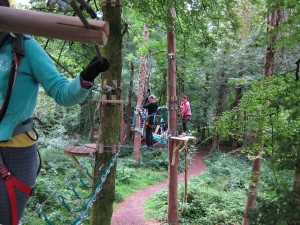 All activities proceed from tree-to-tree, gaining height either gradually on long activities, or steeply on ladders and climbs. Activities require balance at every level, but ropes and hoops offer hand support. Each activity begins and ends on a platform, at which the harness clips are attached to a safety cable and detached from the activity – by design, it is necessary for at least one harness clip to be connected at all times, so you are always connected to a safety cable.
All activities proceed from tree-to-tree, gaining height either gradually on long activities, or steeply on ladders and climbs. Activities require balance at every level, but ropes and hoops offer hand support. Each activity begins and ends on a platform, at which the harness clips are attached to a safety cable and detached from the activity – by design, it is necessary for at least one harness clip to be connected at all times, so you are always connected to a safety cable.
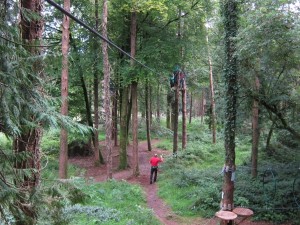 Zip lines use a pulley over the cable and require faith (in the harness) to glide to the landing platform. Staff are on hand throughout the courses to encourage, advise and – in the extreme – rescue participants who either get stuck or become frightened.
Zip lines use a pulley over the cable and require faith (in the harness) to glide to the landing platform. Staff are on hand throughout the courses to encourage, advise and – in the extreme – rescue participants who either get stuck or become frightened.
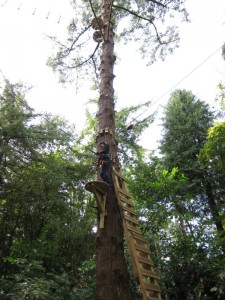 The courses proceed from lower levels (1-2 metres on the first course) to very high (15 metres on the highest two courses), with two moderately difficult “family” courses in the middle (2-8 metres).
The courses proceed from lower levels (1-2 metres on the first course) to very high (15 metres on the highest two courses), with two moderately difficult “family” courses in the middle (2-8 metres).
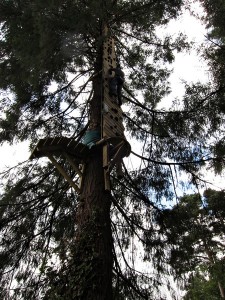 Activities like the climbing wall require upper body strength – you pull yourself up with arm-strength as much as pushing with your legs. The added adrenaline when doing this many metres above the ground will make the activity far more strenuous and demanding than it might seem.
Activities like the climbing wall require upper body strength – you pull yourself up with arm-strength as much as pushing with your legs. The added adrenaline when doing this many metres above the ground will make the activity far more strenuous and demanding than it might seem.
On this climbing wall, more than 8 metres (25 feet) up, you are attached to a safety cable that retracts as you climb, so you will fall less than a metre into your harness if you do lose your grip.
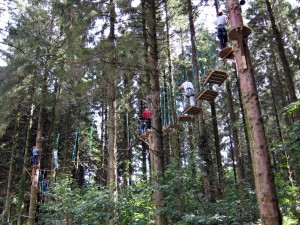 One or more semi-circular platforms offer a rest and a changeover point between activities. Only one participant can use any platform or any activity at one time, so communication with the people in front and behind is essential to keep the movement flowing and make sure that no platforms or activities are overloaded.
One or more semi-circular platforms offer a rest and a changeover point between activities. Only one participant can use any platform or any activity at one time, so communication with the people in front and behind is essential to keep the movement flowing and make sure that no platforms or activities are overloaded.
An interesting feature of the safety-conscious design is that proprioception and balance issues become secondary – every route is designed to carry people without risk of injury from overhead branches, sharp edges or traps between objects.
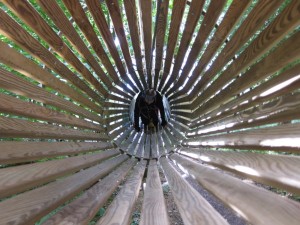 Most activities involve balance, but some are pure fun – like this hamster run hanging from cables. Others involve unicycling along a tightrope and a BMX bike along a plank (always attached to a safety harness).
Most activities involve balance, but some are pure fun – like this hamster run hanging from cables. Others involve unicycling along a tightrope and a BMX bike along a plank (always attached to a safety harness).
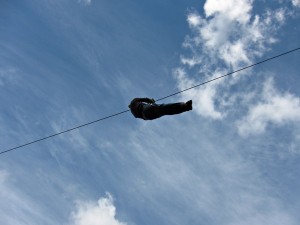 The zipline flights are probably the most pleasurable part of the course. The longest zipline, at the highest course, is 150 metres long. Ziplining between trees under the canopy and out in the open is like flying, once you have conquered the fear of getting up to the top of the zipline run.
The zipline flights are probably the most pleasurable part of the course. The longest zipline, at the highest course, is 150 metres long. Ziplining between trees under the canopy and out in the open is like flying, once you have conquered the fear of getting up to the top of the zipline run.
I had a great sense of achievement, a feeling of competence in handling the course, a boost to my self-esteem in doing something genuinely frightening and an exercise-high that persisted.
